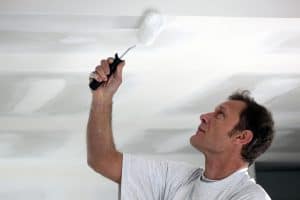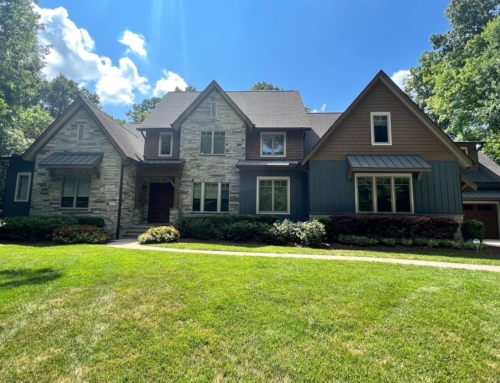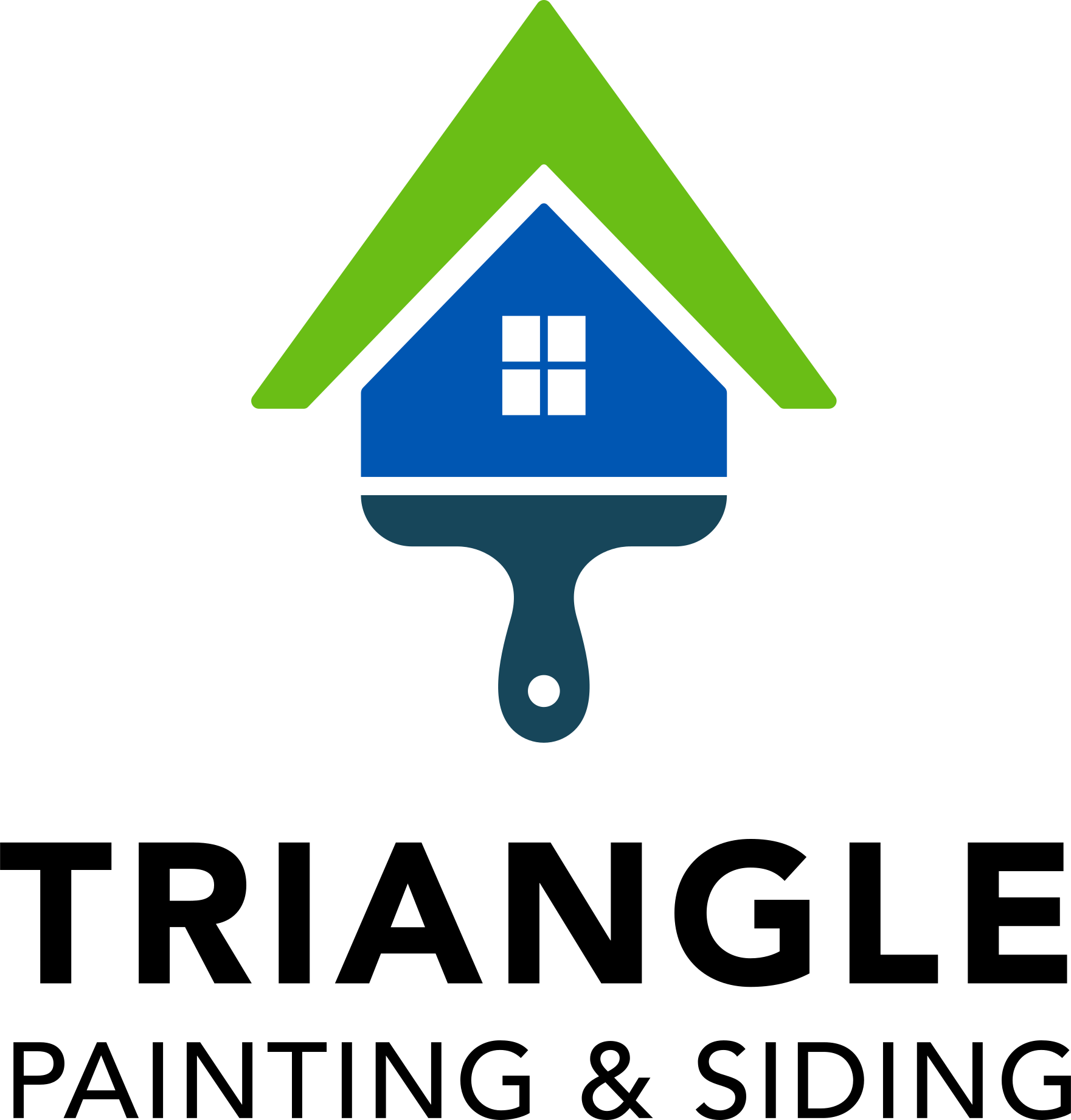When you’re planning to repaint rooms in your house, it’s important to consider not just the walls but also the ceilings. A fresh coat of paint on the ceiling can brighten up the room, cover up imperfections, and even make a statement if you choose a bold color. Ceiling paint is a separate product from wall paint and is designed for easy application and durability. So, don’t forget to look up and give your ceilings the attention they deserve!
Ceiling Paint vs. Wall Paint: What’s the Difference?
 When painting walls, it is common to use latex-based paint to ensure a smooth application. However, using this type of paint on the ceiling can lead to drips and messes due to its low viscosity. Ceiling paint, on the other hand, is thicker and less likely to drip during application, with a higher Krebs Unit (KU) viscosity measurement. In addition to simplifying application and clean-up, the thickness of ceiling paint also makes it better at concealing existing stains. You can tell the difference between ceiling paint and wall paint by comparing their weight – ceiling paint should weigh more due to its higher solids content by weight.
When painting walls, it is common to use latex-based paint to ensure a smooth application. However, using this type of paint on the ceiling can lead to drips and messes due to its low viscosity. Ceiling paint, on the other hand, is thicker and less likely to drip during application, with a higher Krebs Unit (KU) viscosity measurement. In addition to simplifying application and clean-up, the thickness of ceiling paint also makes it better at concealing existing stains. You can tell the difference between ceiling paint and wall paint by comparing their weight – ceiling paint should weigh more due to its higher solids content by weight.
Types of Ceiling Paint
When it comes to ceiling paint, there are different types to choose from depending on the specific needs of your project. It’s important to consider the function of the room you’re painting, as well as the type of ceiling, in order to determine which type of paint is the best fit for the job.
Flat Acrylic Ceiling Paint
Flat paint is the most common type of ceiling paint, and it is best suited for low-humidity rooms like bedrooms and living spaces. It does not reflect much light, which is appropriate for most ceilings.
Satin Sheen Acrylic Ceiling Paint
Flat paint is not suitable for rooms with high humidity as it can be prone to staining, cracking, or chipping. In such cases, it is better to opt for satin sheen ceiling paint, which is more appropriate for spaces like bathrooms, laundry rooms, or any other area with higher humidity levels.
Semi-Gloss Acrylic Ceiling Paint
Semi-gloss ceiling paint is the least likely type of paint to crack in humid spaces, making it the best choice for ceilings directly above a shower stall or any other place subject to a lot of consistent humidity.
Ceiling Paint Costs
On average, a gallon of ceiling paint typically costs between $20 and $60 and can cover up to 400 square feet of space, which is equivalent to a 20-by-20-foot room. In addition to the paint, DIY painters will need to purchase paint brushes, rollers, roller covers, painter’s tape, and a drop cloth, which can add to the overall cost.
If you opt to hire a professional painter, the national average cost to paint the ceiling in a 10-by-12-foot room is $250. However, the cost may vary depending on several factors such as the height and texture of the ceiling, the color of the paint, and other additional requirements.
Ceiling Paint Pros and Cons
Repainting your ceilings might seem like a lot of extra work for minimal results, particularly if you’re sticking with the same general color. However, a fresh coat of ceiling paint can help brighten up the room, conceal stains, and can even add interest if you choose to use a bold color. If you do the project yourself, painting a ceiling is a relatively inexpensive weekend project.
Ceiling Paint Pros
Ceiling paint has a higher viscosity than wall paint, which reduces the likelihood of drips and improves coverage for stains on the ceiling. This makes painting ceilings an easy and cost-effective DIY project.
While white is the traditional color for ceiling paint, there are no hard and fast rules. In fact, a dark ceiling paired with light walls can create a striking and unique effect. So, don’t be afraid to get creative and experiment with different colors to add some personality and character to your space.
Ceiling Paint Cons
Preparing to paint ceilings can require significant time and effort, including removing furniture and fixtures from the room, covering the floors with drop cloths, and using painter’s tape to protect walls and trim. It’s important to ensure that the ceiling is clean and free of debris before beginning to paint.
Leftover ceiling paint can be used for touch-ups or for painting other ceilings in your home. However, it’s important to ensure that the paint is still in good condition before using it again.
If the ceilings are vaulted or located at a high level, it may be risky to attempt to paint them yourself. In such cases, it may be best to hire a professional painter such as Triangle Paint & Siding.
Ceiling Paint Considerations
When one is making a decision on the quantity of paint to purchase, it is essential to factor in the kind of ceiling that is in place. For instance, popcorn ceilings demand a more substantial amount of paint to guarantee that the entire surface area is uniformly covered. Additionally, when buying other painting supplies, it is vital to take into account the ceiling type. For example, a thick nap roller cover is necessary for painting popcorn ceilings.
Notably, although ceiling paints have higher viscosity compared to wall paints, there is a variance in the quality of different types of ceiling paints. If one is acquiring the ceiling paint from a specialty paint store or home improvement store, it is wise to inquire about the disparities in ceiling paint products to determine which is best for the task at hand.
As for the color options, white or off-white hues are the most popular choices for ceilings. However, if the walls of a room are neutral, painters typically suggest tinting the ceiling paint with roughly one-third of the color utilized on the walls in the room. This not only brings the room together but also emphasizes the height of the walls.
When to Call a Ceiling Paint Pro in Raleigh, NC
When undertaking ceiling painting, it is inevitable that one needs to stand on a stable chair or ladder for an extended duration. Depending on the ceiling’s height, this may necessitate using a tall ladder, which understandably poses a safety concern for many individuals. Moreover, painting ceilings can be a laborious process for more significant areas. Engaging a painting expert, like Triangle Painting & Siding, with the necessary tools and expertise, will guarantee a seamless job with minimal disturbance to your daily routine.
Triangle Painting & Siding Are Ceiling Painting Experts
If you would like some professional help with your painting project, Triangle Painting & Siding is here to help. Simply contact us today to get your free quote. We proudly service the entire Research Triangle area, including Raleigh, Cary, Garner, Apex, Wake Forest, Clayton, Holly Springs, Fuquay-Varina, Knightdale, Morrisville, Durham and Chapel Hill, NC.









